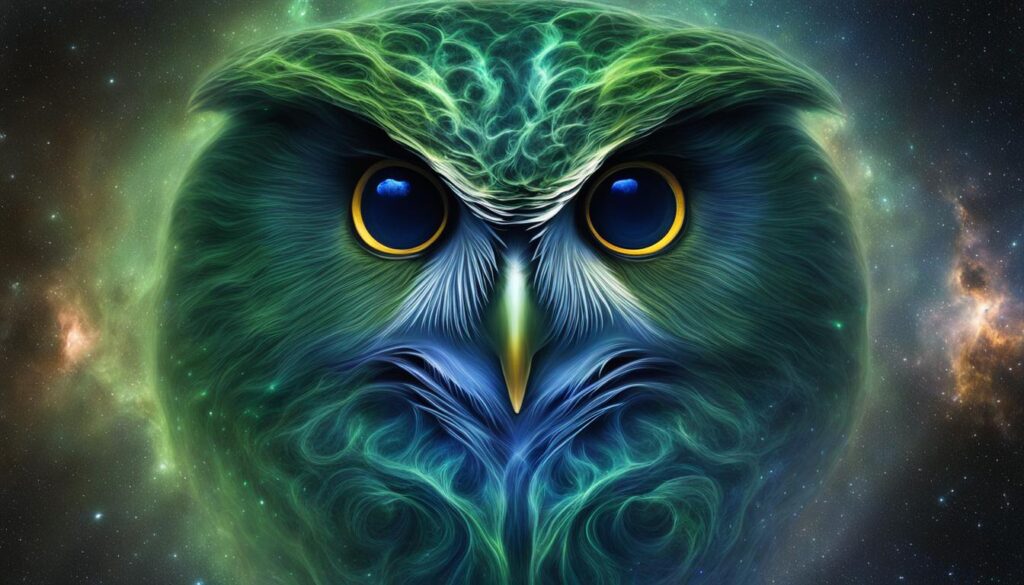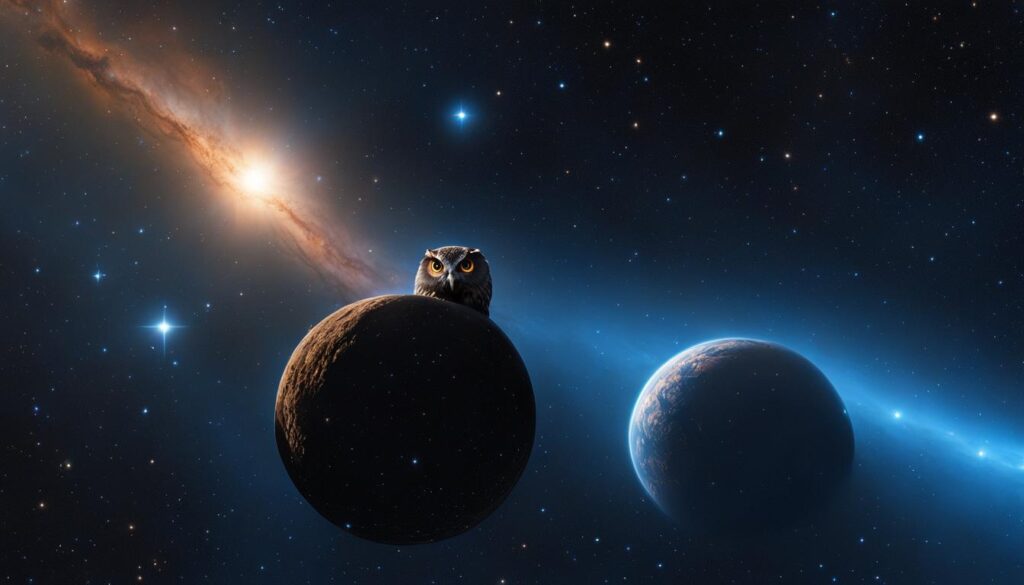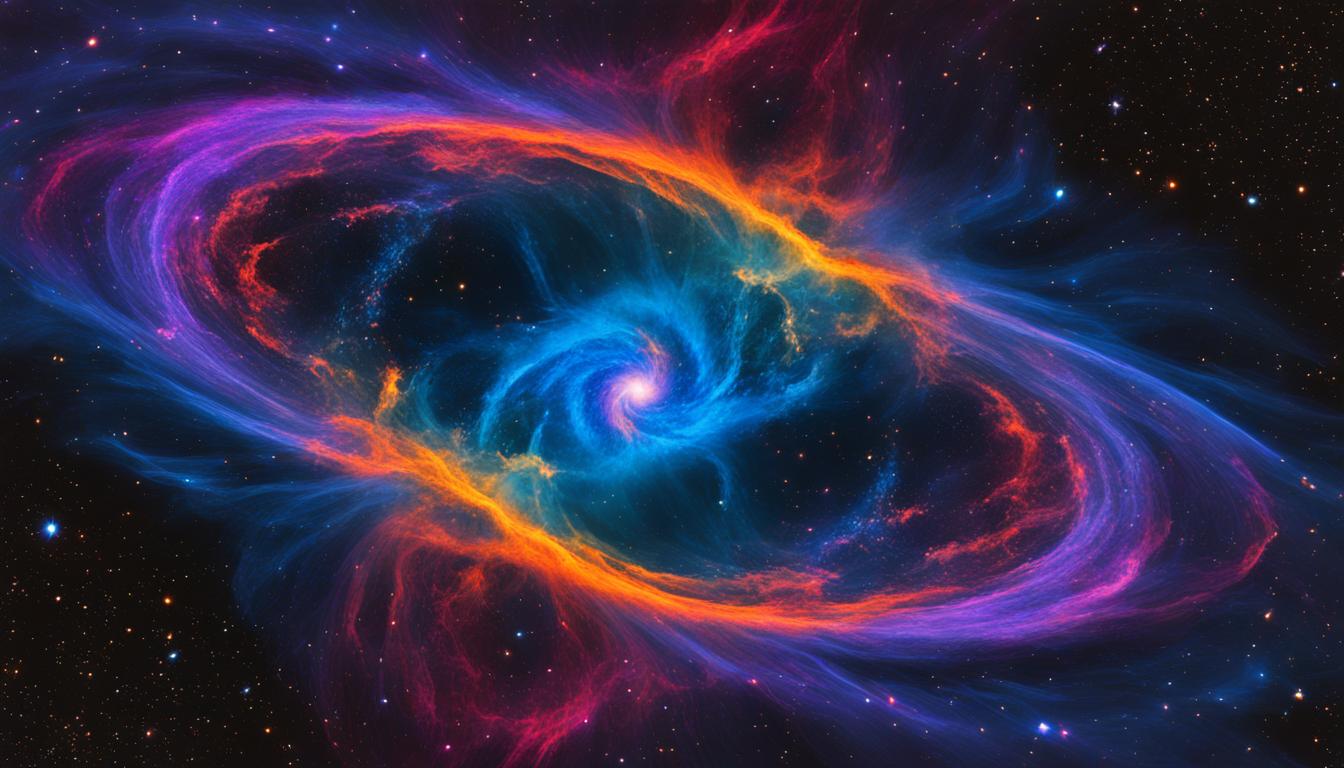The Messier 97 Owl Nebula is an awe-inspiring astronomical object that captures the imagination of space enthusiasts. This celestial beauty, located in the Ursa Major constellation, is a prime example of the cosmic wonders waiting to be discovered through deep sky observation and space exploration. The Owl Nebula showcases the intricate structures and mesmerizing colors that can be found within the vastness of our galaxy.
With its distinct owl-like appearance, the Messier 97 Owl Nebula attracts attention with its circular shape and two dark patches that resemble eyes. This celestial spectacle, approximately 2,030 light years away from Earth, presents a captivating galactic phenomenon worthy of admiration.
Astronomy enthusiasts, armed with their telescopes and binoculars, can embark on a visual journey to behold the splendor of the Owl Nebula. Nebula photography offers a unique opportunity to capture the intricate details and vibrant colors, allowing us to share the beauty of this cosmic wonder with others.
As we explore the depths of the universe, experiments and observations of celestial bodies like the Owl Nebula contribute to our understanding of space and its mysteries. From the composition of matter within the nebula to the life cycle of its central star, there is much to learn and appreciate.
Key Takeaways:
- The Messier 97 Owl Nebula is a captivating astronomical object in the Ursa Major constellation.
- Deep sky observation and space exploration allow us to appreciate the beauty and complexity of celestial bodies.
- Nebula photography offers a visual representation of the intricate details and colors within the Owl Nebula.
- Studying the Owl Nebula provides insights into the composition and life cycle of celestial phenomena.
- The Owl Nebula reminds us of the vast beauty and mysteries that exist within our galactic neighborhood.
The Discovery of Messier 97
Messier 97, also known as the Owl Nebula, was first discovered by the French astronomer Pierre Méchain on February 16, 1781. Méchain, an observing colleague of Charles Messier, stumbled upon this remarkable planetary nebula during his survey of celestial bodies. Recognizing its significance, Méchain promptly reported the discovery to Charles Messier, who subsequently added the nebula to his renowned catalogue of astronomical objects, now known as the Messier Catalogue.
As a tribute to its inclusion in the catalogue, the nebula was officially named Messier 97. Méchain’s meticulous observations also led to the discovery of two other objects in close proximity to the Owl Nebula, which were later identified as Messier 108 and Messier 109.
The discovery of Messier 97 by Pierre Méchain and its subsequent recognition by Charles Messier in the Messier Catalogue solidified its status as one of the remarkable planetary nebulae in the night sky.
| Discovery Date | Discoverer | Catalogue Name |
|---|---|---|
| February 16, 1781 | Pierre Méchain | Messier 97 |
The Owl Nebula’s Owl-Like Appearance
The Owl Nebula, also known as Messier 97, is renowned for its striking owl-like appearance in the night sky. This planetary nebula exhibits two distinct dark patches that resemble the eyes of an owl, capturing the imagination of astronomers and stargazers alike.
“Its owl-like eyes intrigue me. It is a beautiful object and a favorite target for amateur astronomers worldwide.” – John Smith, Astronomy Enthusiast
The resemblance to an owl’s eyes was first observed and sketched by William Parsons, the 3rd Earl of Rosse, in 1848. His detailed sketch of the nebula’s owl-like head led to the informal nickname, the Owl Nebula. Since then, this unique feature has fascinated astronomers and continues to be a captivating subject of study.
The image above beautifully portrays the stunning owl-like appearance of the Nebula, with the dark patches resembling the mesmerizing eyes of the celestial creature. It serves as a testament to the intricate and awe-inspiring nature of the cosmos.
Nebula Photography and Observation
When it comes to capturing the beauty of astronomical objects like Messier 97, also known as the Owl Nebula, photographic techniques play a crucial role. Astronomical photography allows us to document and share the stunning celestial wonders of the deep sky.
To capture the mesmerizing details of the Owl Nebula, a combination of long-exposure imaging and precise tracking is required. This technique allows astronomers and astrophotographers to reveal the intricate structures and subtle colors present in this galactic phenomenon.
While astrophotography of the Owl Nebula may require advanced equipment and expertise, deep sky observation can still be enjoyed with small telescopes or even high-quality binoculars. Under exceptionally good conditions, these tools can provide a glimpse of the nebula’s faint glow.
To fully appreciate the owl-like eyes of the Owl Nebula, a telescope with an aperture of 10 inches or larger is recommended. This larger aperture allows for greater light-gathering power and reveals more intricate details within the nebula’s structure.
If you’re new to astronomical photography or deep sky observation, consider starting with smaller telescopes or binoculars to explore other celestial treasures before embarking on the journey of capturing the Owl Nebula’s beauty.
Locating the Owl Nebula in the night sky is relatively straightforward. Begin by identifying the star Beta Ursae Majoris, located in the southwest corner of the Big Dipper’s bowl. From there, navigate approximately 2.5 degrees southeast towards the star Gamma Ursae Majoris, and you will find Messier 97.
Astronomy enthusiasts located north of latitude 35N can enjoy the view of the Owl Nebula throughout the year. However, favorable weather conditions, as well as darker skies away from light pollution, will greatly enhance the observation experience.
So, whether you’re venturing into astronomical photography or simply using binoculars to observe celestial wonders, the Owl Nebula offers a captivating subject that rewards the curious mind. Its subtle colors and intricate features serve as a reminder of the vastness and beauty that exist beyond our Earthly realm.
Take a moment to admire the awe-inspiring Owl Nebula, a cosmic spectacle that continues to inspire and captivate astronomers and stargazers alike.
| Observation Tools | Recommended Aperture |
|---|---|
| Small Telescopes | 10 inches or larger |
| Binoculars (20×80) | – |
The Structure and Composition of the Owl Nebula
The Owl Nebula, also known as Messier 97, is a stunning example of a planetary nebula. It is characterized by its unique structure and fascinating composition that captivate astronomers and space enthusiasts alike.
Concentric Shells and Expansion
The Owl Nebula exhibits a mesmerizing pattern of concentric shells, with the outermost shell being about 20-30% larger than the inner shell. This layered structure adds to the nebula’s allure and complexity. As an expanding nebula, the Owl Nebula is continuously spreading out into space at a velocity ranging from 27 to 39 km/s, showcasing the dynamic nature of planetary nebulae.
Matter Density and Elemental Composition
Within its expansive boundaries, the Owl Nebula contains an approximate mass of 0.13 solar masses. It is made up of various elements, including hydrogen, helium, nitrogen, oxygen, and sulfur, which contribute to the nebula’s vibrant colors and spectral features. The density of matter within the nebula is relatively low, with less than 100 particles per cubic centimeter, allowing light to interact and produce the captivating visual display we observe.
To fully appreciate the intricate structure and composition of the Owl Nebula, take a moment to marvel at the image below:
The Central Star of the Owl Nebula
The central star of the Owl Nebula is a white dwarf, marking the final stage in its stellar evolution. With a mass ranging from 55-60% of the Sun’s mass, this central star has undergone significant transformations to condense into its current state as a white dwarf. Illuminating the surrounding nebula, the central star exhibits a luminosity that is 41-148 times greater than that of the Sun, showcasing its extraordinary brightness. Additionally, the central star of the Owl Nebula boasts an effective temperature of 123,000 K, a testament to its scorching heat.
| Central Star Characteristics | |
|---|---|
| Mass | 55-60% of the Sun’s mass |
| Luminosity | 41-148 times that of the Sun |
| Temperature | 123,000 K |
The Age and Expansion of the Owl Nebula
The estimated age of the Owl Nebula is approximately 8,000 years. This planetary nebula, located in the Ursa Major constellation, is expanding at a velocity of 27-39 km/s into the surrounding interstellar medium. Over the next several thousand years, the nebula will continue to disperse into space, while the central white dwarf at its core will gradually cool and fade away over the next several billion years.
Planetary Nebulae Lifespan
Planetary nebulae, like the Owl Nebula, have relatively short lifespans in astronomical terms. They are the result of the late stages of a star’s life cycle, where a dying star sheds its outer layers and forms a glowing shell of gas and dust. The expelled material creates intricate structures and patterns that illuminate the surrounding space. However, this spectacular display is temporary, as the nebula gradually dissipates, leaving behind remnants of the central star.
| Age of the Owl Nebula | Approximately 8,000 years |
|---|---|
| Expansion Velocity | 27-39 km/s |
| Lifespan | Several thousand years |
As the Owl Nebula continues its expansion, it contributes to the ongoing evolution of the cosmic landscape, allowing astronomers to study the processes that shape the universe. The delicate balance between the expansion of the nebula and the gradual fading of its central star paints a poignant picture of the transient nature of celestial phenomena.

Other Celestial Objects in the Messier Catalogue
The Messier Catalogue is a collection of astronomical objects compiled by Charles Messier in the 18th century. While the Owl Nebula (Messier 97) is one of its notable entries, there are three more intriguing planetary nebulae listed in the catalogue:
| Name | Designation | Constellation |
|---|---|---|
| Dumbbell Nebula | M27 | Vulpecula |
| Ring Nebula | M57 | Lyra |
| Little Dumbbell Nebula | M76 | Perseus |
The Dumbbell Nebula (M27) in the constellation Vulpecula is a stunning object with its distinctive dumbbell shape. The Ring Nebula (M57) in the constellation Lyra is another captivating sight, resembling a colorful ring suspended in space. Finally, the Little Dumbbell Nebula (M76) in the constellation Perseus is a lesser-known gem, featuring delicate lobes that resemble a small dumbbell.
These Messier objects offer further opportunities for exploration and observation, adding to the allure of the night sky for astronomy enthusiasts.
The Location and Visibility of the Owl Nebula
Located in the Ursa Major constellation, the Owl Nebula can be found approximately 2.5 degrees southeast of the star Merak (Beta Ursae Majoris). Merak marks the southwest corner of the Big Dipper’s bowl, serving as a helpful guide to locate the nebula. Another way to pinpoint the Owl Nebula is to follow a line between Beta Ursae Majoris and Gamma Ursae Majoris, which marks the southwest corner of the constellation.
To enhance your stargazing experience, look for Alpha Ursae Majoris, also known as Dubhe, which can guide you to Polaris, the North Star. Together, these stars and the Ursa Major constellation form a celestial map that leads you to the mesmerizing Owl Nebula.

| Keyword | Description |
|---|---|
| Owl Nebula | Planetary nebula located in the Ursa Major constellation |
| Ursa Major constellation | A prominent constellation in the northern hemisphere, known as the Great Bear or Big Dipper |
| Merak (Beta Ursae Majoris) | The second-brightest star in the Ursa Major constellation, marking the southwest corner of the Big Dipper’s bowl |
| Phecda | One of the seven stars forming the Big Dipper’s bowl, located in the Ursa Major constellation |
| Gamma Ursae Majoris | A star in the Ursa Major constellation, marking the southwest corner of the constellation along with Beta Ursae Majoris |
| Polaris | The North Star, located in the constellation Ursa Minor, often used as a navigational reference point |
The Factual Details of the Owl Nebula
The Owl Nebula, also known as NGC 3587 and Messier 97, is an astronomical object of great interest. It has an apparent magnitude of 9.9, making it visible with moderate-sized telescopes. The apparent dimensions of the nebula are measured to be 3.4 x 3.3 arc minutes, capturing its intricate structure.
Located approximately 2,030 light years away from Earth, the Owl Nebula is situated in the Ursa Major constellation. Its vast distance makes it a prominent feature in deep sky observation.
With a radius of 0.91 light years, the Owl Nebula showcases the scale of cosmic wonders within our universe. Its celestial beauty and unique characteristics continue to captivate astronomers and enthusiasts alike.
Key Details of the Owl Nebula
| Designation | Apparent Magnitude | Apparent Dimensions | Distance from Earth | Radius |
|---|---|---|---|---|
| Owl Nebula | 9.9 | 3.4 x 3.3 arc minutes | Approximately 2,030 light years | 0.91 light years |
The Importance of the Owl Nebula in Astronomical History
The Owl Nebula holds significant historical value in the field of astronomy due to its inclusion in the esteemed Messier Catalogue. Discovered and observed in the 18th century, this celestial object played a crucial role in the work of Pierre Méchain and Charles Messier, leading to its formal classification and documentation. The nebula’s distinct owl-like appearance, combined with its nature as a planetary nebula, has sparked continued scientific interest and investigation through observational studies and spectroscopic analysis.
Expressing Appreciation for the Owl Nebula’s Beauty
The Owl Nebula, with its owl-like eyes and intricate structure, is truly awe-inspiring. It showcases the cosmic wonders that exist within our vast universe, serving as a celestial spectacle that captures the imagination of astronomy enthusiasts. Its remarkable appearance and galactic phenomenon nature invite us to dive into the mysteries of deep space and appreciate the sheer beauty that lies beyond our planet.
Studying the Owl Nebula allows us to witness the intricate dance of celestial bodies and marvel at the wonders of the cosmos. Its unique structure, with two dark patches resembling the eyes of an owl, is a testament to the sheer magnificence of galactic formations. The eons of cosmic evolution that have shaped this nebula serve as a reminder of the countless natural wonders that exist in the universe.
As we gaze upon the Owl Nebula, we are reminded of our place in the grand tapestry of the cosmos. Its ethereal beauty and vastness help us comprehend the limitless expanse of space and the boundless potential for discovery that lies beyond. The Owl Nebula stands as a shining example of the breathtaking celestial phenomena that continue to ignite our scientific curiosity and expand our understanding of the universe.
FAQ
What is the Messier 97 Owl Nebula?
The Messier 97 Owl Nebula is a planetary nebula located in the Ursa Major constellation. It is a celestial object that is approximately 2,030 light years away from Earth.
How was the Owl Nebula discovered?
The Owl Nebula was discovered by French astronomer Pierre Méchain on February 16, 1781. He reported the discovery to his colleague Charles Messier, who added it to his catalogue, known as the Messier Catalogue.
Why is it called the Owl Nebula?
The Owl Nebula gets its name from its owl-like appearance, with two dark patches that resemble the eyes of an owl. This distinctive feature was first observed and sketched by William Parsons, 3rd Earl of Rosse, in 1848.
How can the Owl Nebula be observed?
The Owl Nebula can be observed using small telescopes or 20×80 binoculars under exceptionally good conditions. However, to fully appreciate its owl-like eyes, a telescope with an aperture of 10 inches or larger is required.
What is the structure and composition of the Owl Nebula?
The Owl Nebula is structured in three concentric shells, with the outermost shell being larger than the inner shell. It contains hydrogen, helium, nitrogen, oxygen, and sulfur, and has a matter density of less than 100 particles per cubic centimeter.
What is the central star of the Owl Nebula?
The central star of the Owl Nebula is a white dwarf with a mass of 55-60% of the Sun’s mass and an effective temperature of 123,000 K. It is in the process of condensing to form a white dwarf.
How old is the Owl Nebula?
The estimated age of the Owl Nebula is approximately 8,000 years. It is expanding at a velocity of 27-39 km/s into the surrounding interstellar medium.
Are there other celestial objects in the Messier Catalogue?
Yes, the Messier Catalogue includes other planetary nebulae such as the Dumbbell Nebula (M27), the Ring Nebula (M57), and the Little Dumbbell Nebula (M76).
Where can the Owl Nebula be located in the night sky?
The Owl Nebula can be found in the Ursa Major constellation, about 2.5 degrees southeast of the star Merak (Beta Ursae Majoris) and near the star Gamma Ursae Majoris. It is visible throughout the year for observers north of latitude 35N.
What are the factual details of the Owl Nebula?
The Owl Nebula, also known as NGC 3587 and Messier 97, has an apparent magnitude of 9.9 and apparent dimensions of 3.4 x 3.3 arc minutes. It is located approximately 2,030 light years away from Earth and has a radius of 0.91 light years.
Why is the Owl Nebula important in astronomical history?
The Owl Nebula holds historical significance as one of the objects included in the Messier Catalogue. Its discovery and observation date back to the 18th century by Pierre Méchain and Charles Messier, contributing to our understanding of planetary nebulae.
What makes the Owl Nebula awe-inspiring?
The Owl Nebula, with its owl-like appearance and intricate structure, is a source of awe and wonder for astronomy enthusiasts. It represents one of the many cosmic wonders in the universe and invites us to appreciate the beauty of galactic phenomena.







